Learn how to cook dried beans and enjoy saving money, cooking from scratch, and a higher variety of meatless meals. Feel confident in using your food storage, and enjoy the wide variety of meals that can be based off of beans, including chili, hummus, and lentil soup.
How to cook dried beans
You’ve got dried beans in your food storage, just in case. They are cheaper to buy than canned beans and last almost indefinitely. But, your family has never eaten dried beans before. In fact, your idea of “chili” is 2 cans of kidney beans, a pound of ground beef, a jar of tomato sauce, an onion, a head of garlic, and a teaspoon of taco seasoning, topped with cheddar cheese, lots of cheddar cheese. Where do you even begin to use dried beans from your food storage?
First of all, beans are the lynchpin of protein in the vegetable world. Beans are a good source of complex carbohydrates, too. They are rich in vitamins and minerals including the B-complex vitamins, iron, calcium, potassium, zinc, and magnesium. While the protein in beans is incomplete, needing grain or nuts to complete it, it remains a valuable protein source in many cuisines. If you add a small amount of animal products like cheese, yoghurt, or meat the protein profile will complete itself.
Dried beans vs. canned beans cost comparison
- 1 cup of dried beans yields 3 cups of cooked beans or the equivalent of 2 – 15 oz. cans.
- There is 1 ½ cups of cooked beans in a 15 ounce can of beans.
- ½ cup of cooked beans is 1 serving.
- 1- 15 oz. can has 3 servings of cooked beans.
- 1 cup of dried beans weighs approximately ½ lb.
- ¼ lb. of dried beans equals the amount of dried beans in a 15 oz. can of beans.
- ¼ lb. or ½ cup of dried beans makes 3 servings of cooked beans.
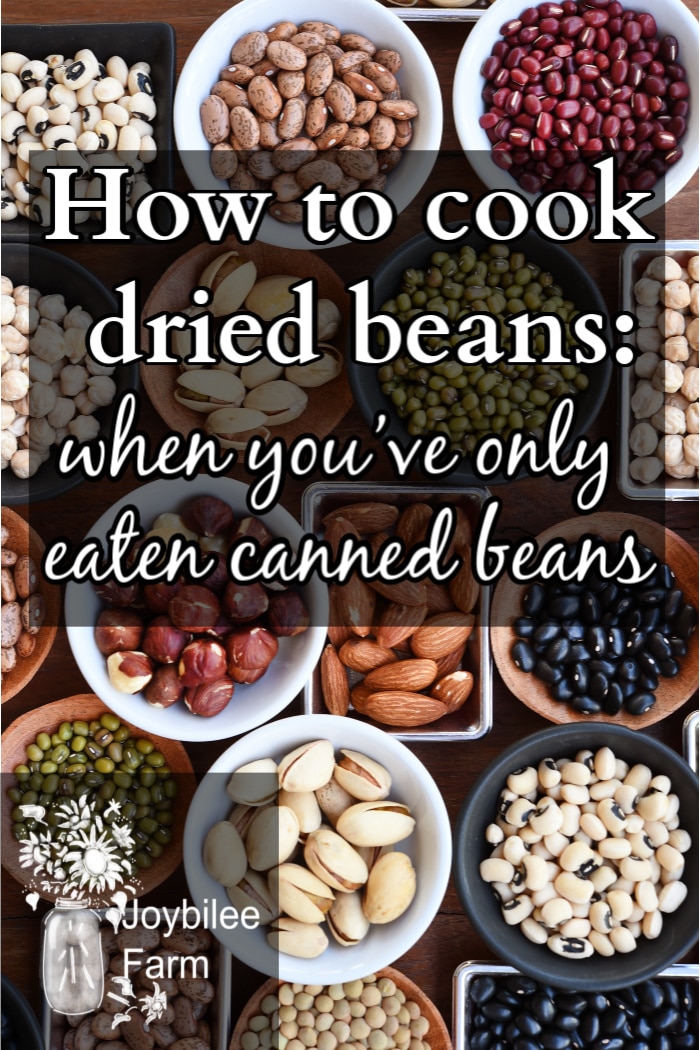
Eating dried beans instead of opening a can is going to save you money, most of the time. There is a wide spread price range for canned beans from$1.75 US to as much as $3.50US for organic canned beans. That’s about $7 to $14 a lb. for the dried bean equivalent. If you were buying canned beans to save money over the cost of meat, you might reconsider – steak might just be cheaper. On the other hand dried beans when bought by the bulk bag, cost from 30 cents to 75 cents for the dried bean equivalent of a single can or $1.20 cents to $3 a lb.
Rule of 4
To figure out what you are paying where you live take the cost of a 15 oz. can of beans in the variety you most commonly buy, and multiply by 4 to get the cost per lb of dried beans. Or take the cost per lb. of dried beans and divide by 4 to get the cost of the equivalent of 1 can of beans when using dried beans. This will show you where the cost savings is.
Dried beans may not always be the best buy. When dried beans are in excess of $12 per lb, or canned beans are below $1 a can, you might find that it’s cheaper to buy canned. On the other hand, for practical long term food storage needs, canned goods expire after a year, whereas dried beans will remain good for several years, even a decade, depending on how they are stored. So keep this in mind in your cost comparison.
Health concerns of canned beans
Frugality isn’t the only reason to choose dried beans over canned. You’ll be healthier, too, using dried beans. Some canned beans have BPA in the cans, since many aluminum cans have a plastic coating – even drink cans have the plastic coating inside them. BPA is implicated in birth defects, hormonal imbalance, and cancer. So making your own beans from the dried ones lets you skip the BPA.
How to use dried beans
The difference between the convenience of canned beans and frugality of dried beans is just water, time, and some simmering.
And you can pressure can your own dried beans, to get the best of both frugality and convenience. If you want to pressure can your own dried beans, see this post for directions. It’s not hard.
Why begin with dried beans?
- All beans contain indigestible carbohydrates. These are the flatulent factor, also called “bean bloat”. This flatulent factor remains in canned beans and results in after-meal discomfort. But when you start with dried beans or even pressure can your own beans, you can minimize the flatulent factor.
- Dried beans are much cheaper than canned beans. (see above)
- Dried beans are available in many attractive varieties that aren’t found in canned beans.
- Dried beans are the beans that come out of your own garden or your local farmer’s market. They might be local.
- When you buy organic dried beans in bulk, you can plant them next spring and grow more, for a perpetual supply. Non-organic dried beans may have been treated to prevent sprouting, so choose organic if you intend to grow your own beans.
- Organic dried beans and peas can also be used for sprouting, giving your more variety for winter meals. Adzuki and mung beans are excellent beans for sprouts. Whole peas can also be used for sprouts, as well as microgreens.
Step by step guide to cooking dried beans
- Sort beans and remove any foreign objects, rocks, and gravel.
- Rinse beans under running water to remove dust and dirt.
- All beans except lentils, adzuki beans, and split peas should be soaked overnight in 4 times their volume of water. For 1 cup of rinsed, dried beans add 4cups of water to your soaking container.
- In the morning, discard the soaking water. Rinse the beans in a colander until the water stops foaming and bubbling. In a stock pot or slow cooker, add beans and 3 cups of water for each cup of beans. Bring to a boil. Simmer until the beans are soft and tender. It takes around 4 to 6 hours on high in a slow cooker or consult the chart below for stove top cooking. When the beans are done they will be soft throughout but not mushy.
- Again discard the cooking water. Rinse the cooked beans in a colander until the water runs clear and there is no bubbling. Use them as you would canned beans in your recipe.
- Don’t add acid food like tomatoes, until the beans are tender. Acid stops the beans from softening.
- Add salt in the last 15 minutes of cooking time, after the skin on the beans is tender. The beans will absorb the salt once they are partially cooked. Adding the salt earlier in the cooking process prevents the beans from softening during cooking.
- 1 cup of dried beans makes 3 cups of cooked beans.
- Extra cooked beans can be frozen in 1 ½ cup portions to be used in your recipes. Extra cooked beans will keep in the refrigerator for 2 to 4 days. Freeze unused portions.
How to prevent Bean Bloat
When you first begin eating beans you may find that it takes a bit to get used to digesting them.
- Soaking the beans overnight and rinsing several times during the cooking process, as I described above, will remove a lot of the indigestible starch.
- Add carminative herbs and spices like cinnamon, ginger, rosemary, cardamom, orange zest, anise or fennel seed to the dish. Carminative herbs and spices relax the colon and bowel and aid digestion.
- Begin the meal with a bitter tonic or a salad rich in bitter leaves like arugula, chicory, or romaine lettuce. Bitter herbs aid digestion by stimulating the production of both bile and gastric juices.
- Finish the meal with a cup of chamomile tea, peppermint tea, or chai to aid digestion and relax the stomach.
- Add a naturally fermented food to the meal to encourage the right probiotics – kefir or yoghurt, sauerkraut, naturally fermented salsa, or even pickles can help digestion and lessen bean bloat.
- The high fiber content in beans contributes to bean bloat. Simply eating beans more frequently can allow your body to get used to them, and lessen bean bloat.
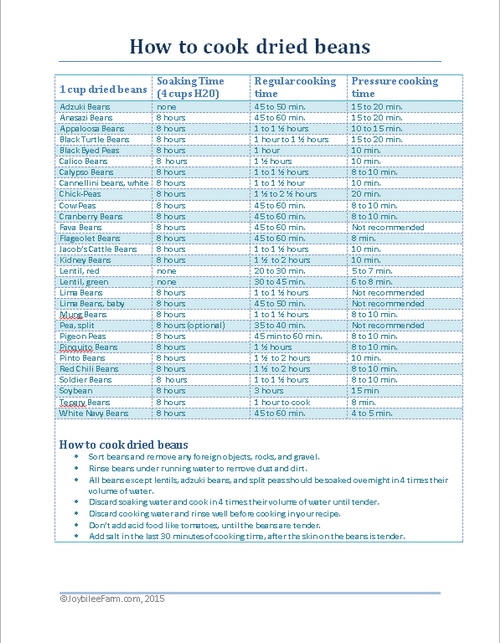
How to cook dried beans
1 cup dried beans |
Soaking Time (4 cups H20) |
Regular cooking time |
Pressure cooking time |
| Adzuki Beans | none | 45 to 50 min. | 15 to 20 min. |
| Anasazi Beans | 8 hours | 45 to 60 min. | 15 to 20 min. |
| Appaloosa Beans | 8 hours | 1 to 1 ½ hours | 10 to 15 min. |
| Black Turtle Beans | 8 hours | 1 to 1 ½ hours | 15 to 20 min. |
| Black Eyed Peas | 8 hours | 1 hour | 10 min. |
| Calico Beans | 8 hours | 1 ½ hours | 10 min. |
| Calypso Beans | 8 hours | 1 to 1 ½ hours | 8 to 10 min. |
| Cannellini beans, white | 8 hours | 1 to 1 ½ hour | 10 min. |
| Chick-Peas | 8 hours | 1 ½ to 2 ½ hours | 20 min. |
| Cow Peas | 8 hours | 45 to 60 min. | 8 to 10 min. |
| Cranberry Beans | 8 hours | 45 to 60 min. | 8 to 10 min. |
| Fava Beans | 8 hours | 45 to 60 min. | Not recommended |
| Flageolet Beans | 8 hours | 45 to 60 min. | 8 min. |
| Jacob’s Cattle Beans | 8 hours | 1 to 1 ½ hours | 10 min. |
| Kidney Beans | 8 hours | 1 ½ to 2 hours | 10 min. |
| Lentil, red | none | 20 to 30 min. | 5 to 7 min. |
| Lentil, green | none | 30 to 45 min. | 6 to 8 min. |
| Lima Beans | 8 hours | 1 to 1 ½ hours | Not recommended |
| Lima Beans, baby | 8 hours | 45 to 50 min. | Not recommended |
| Mung Beans | 8 hours | 1 to 1 ½ hours | 8 to 10 min. |
| Pea, split | 8 hours (optional) | 35 to 40 min. | Not recommended |
| Pigeon Peas | 8 hours | 45 min to 60 min. | 8 to 10 min. |
| Pinquito Beans | 8 hours | 1 ½ hours | 8 to 10 min. |
| Pinto Beans | 8 hours | 1 ½ to 2 hours | 10 min. |
| Red Chili Beans | 8 hours | 1 ½ to 2 hours | 8 to 10 min. |
| Soldier Beans | 8 hours | 1 to 1 ½ hours | 8 to 10 min. |
| Soybean | 8 hours | 3 hours | 15 min |
| Tepary Beans | 8 hours | 1 hour to cook | 8 min. |
| White Navy Beans | 8 hours | 45 to 60 min. | 4 to 5 min. |
How to cook dried beans
|
|||
Download this chart (pdf)
More Bean Recipes:
Lentils don’t require presoaking
Pulled Pork and Lentil Soup from Livin’ Lovin’ Farm
Lentils and Rice from Schneiderpeeps
Chili and Refried Beans Recipes
Buttercup Squash and Black Bean Chili from Homespun Seasonal Living
Refried Beans from Attainable Sustainable
Chick Peas and Garbonzo Bean Recipes
Easy Hummus from Attainable Sustainable
Chick Pea Salsa from Homestead Lady
Navy Bean Recipes
Homemade Baked Beans from Common Sense Homesteading
Bean Soup with Ham from Common Sense Homesteading
How to make your own canned beans
You’ll need a pressure canner with this one. Don’t try to water bath can low acid foods. Freezing may be a simpler way to preserve cooked beans, if you don’t have a pressure canner available.
Your Turn:
What one thing keeps you from using the food in your food storage? Or prevents you from keeping it rotating?


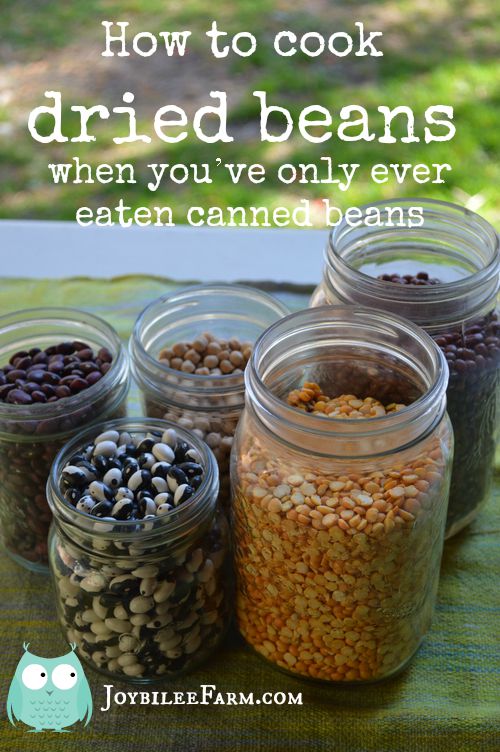
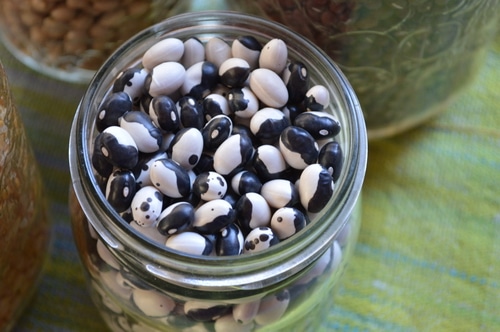
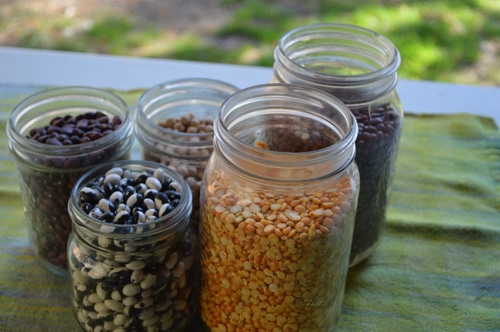


Thanks for the super informative post! We have a ton of dried beans but never actually use them. I’m definitely going to try!
Can I also suggest that you look into possibly optimizing your blog for mobile use? The number of ads I’ve had cover the screen make it really difficult to read what I came here for.